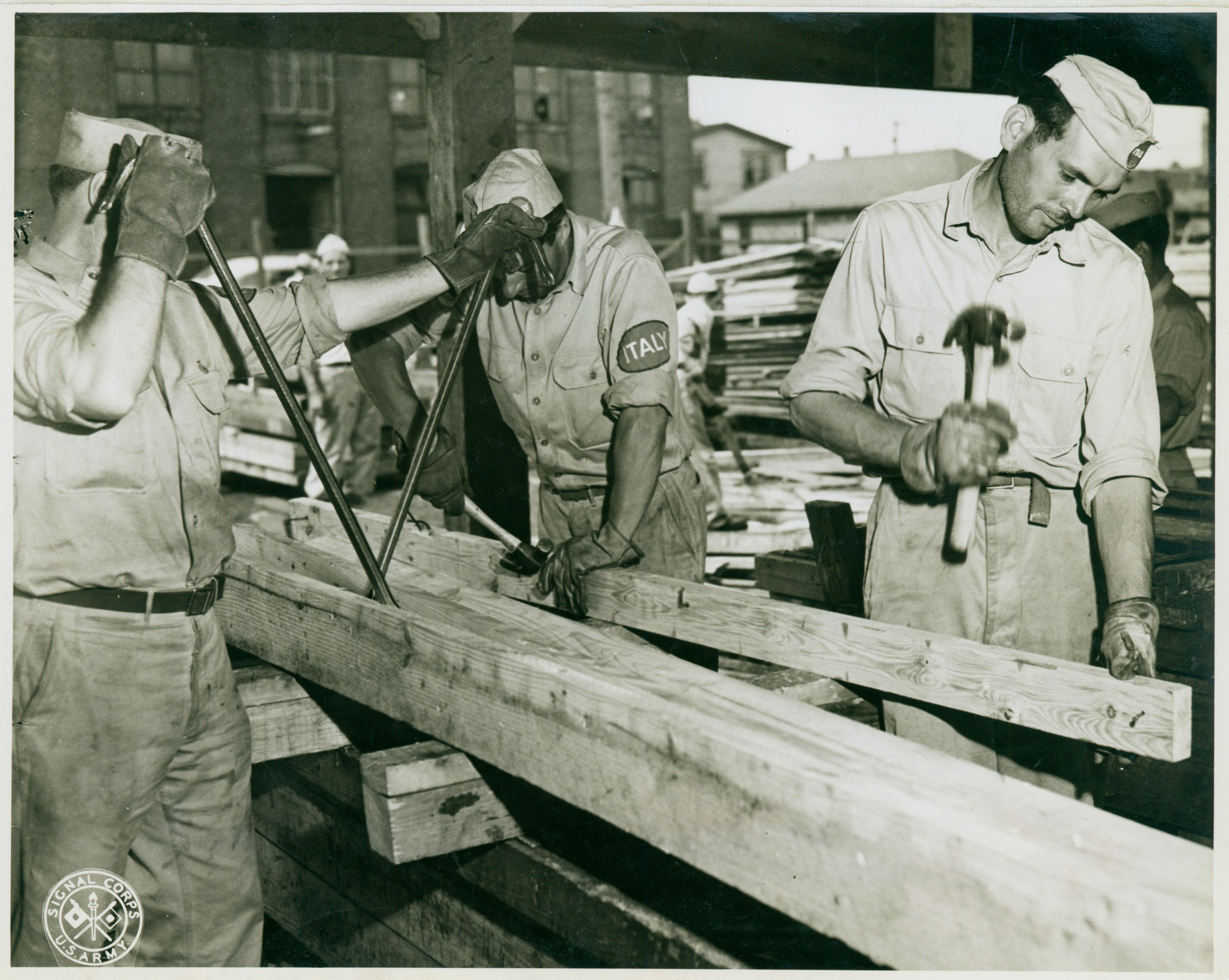During World War II, the uniforms worn by soldiers were powerful symbols of national identity and allegiance. While we often picture Axis and Allied forces in starkly contrasting attire, the story of Italian prisoners of war (POWs) in the United States and their uniforms adds a fascinating layer of complexity. This article explores the unique uniforms worn by Italian POWs who volunteered for Italian Service Units in America, highlighting a little-known chapter of WWII history.
In November 1942, following the Allied forces’ successful North Africa invasion, over 51,000 Italian POWs were transported to the United States and placed in POW camps across the country. The landscape shifted dramatically in September 1943. Allied forces landed in mainland Italy, and by September 8th, Italy, under General Pietro Badoglio (who had taken power after Benito Mussolini’s arrest), surrendered to the Allies. This pivotal moment led to a significant change in how the U.S. military viewed Italian POWs.
 Italian Service Unit Receiving Supplies, Boston Port of Embarkation, South Boston, Massachusetts. Italian POW service units receiving supplies at the port of embarkation in Boston during World War 2.
Italian Service Unit Receiving Supplies, Boston Port of Embarkation, South Boston, Massachusetts. Italian POW service units receiving supplies at the port of embarkation in Boston during World War 2.
With Italy’s surrender and subsequent declaration of war against Germany on October 13, 1943, the perception of Italian POWs in American eyes began to evolve. No longer seen solely as enemies, they were now potential allies in the fight against Nazi Germany. This shift paved the way for a remarkable initiative: the creation of Italian Service Units.
Beginning in February 1944, the U.S. Army Service Corps presented an opportunity to Italian POWs held in American camps. They could volunteer to join what became known as Italian Service Units. This program offered participating POWs jobs, financial compensation, and a degree of freedom of movement within the confines of their designated areas. To join, prisoners had to pledge allegiance to the new Badoglio government and undergo screening to ensure they were not pro-Fascist.
Out of the approximately 51,000 Italian POWs then in the United States, an impressive 45,000 embraced this opportunity and enlisted in the Service Units. These units were strategically deployed to locations across the U.S. facing labor shortages. The remaining 5,000, who either declined to volunteer or were considered pro-Fascist, were relocated to more isolated camps in states like Texas and Arizona.
Each Italian Service Unit comprised between 40 and 250 men, commanded by an Italian officer. These units collaborated with both military and civilian personnel, providing crucial support to various sectors, including agriculture, hospitals, Army depots, seaports, and Army training centers. Crucially, to signify their new role, members of the Italian Service Units were issued American uniforms, albeit with distinctive Italian Service Unit insignia and badges.
 Italian Service Unit receiving supply of beer via railroad car, Boston Port of Embarkation, South Boston, Massachusetts. Italian service unit soldiers unloading beer supplies from a train car at the Boston port during World War 2.
Italian Service Unit receiving supply of beer via railroad car, Boston Port of Embarkation, South Boston, Massachusetts. Italian service unit soldiers unloading beer supplies from a train car at the Boston port during World War 2.
In the Boston, Massachusetts area, around 3,000 Italian prisoners were held in various camps. Many of these men chose to join the service units. While still officially classified as POWs, they donned uniforms that were nearly identical to those worn by American soldiers. The key distinction was a patch bearing the word “Italy,” sewn onto the left sleeve and garrison cap. This “Italy” patch on their WWII uniforms was a clear identifier, differentiating them from American personnel while still signifying their contribution to the Allied cause.
Beyond the uniform, these Italian service members received a monthly payment of $24. However, only one-third of this was paid in cash; the remaining amount was issued as scrip, redeemable at the base for supplies and personal items.
A Boston Globe article from May 15, 1944, highlighted an Italian Service Unit working in Franklin Park, Boston, noting it as the first of its kind in the nation. The article emphasized that “The men wear American Army uniforms carrying the insignia of ‘Italy’ and are supervised by Italian officers, and we believe is the first unit employed in such work.”
The presence of these Italian units in the Boston area sparked considerable interest among Italian Americans living there. Thousands sought out the low-security camps and work sites, hoping to find relatives, family friends, or simply to gain news from their ancestral hometowns in Italy. The influx of visitors became so significant that Boston police had to assign military police details to manage the crowds of information seekers.
The primary task for the Italian prisoners was loading combat materials at the South Boston Army Base’s Port of Embarkation, destined for the European theater. However, their roles extended to various tasks in the Boston area, including park maintenance and road construction, demonstrating their versatility and willingness to contribute to the war effort.
 Italian Service Unit palletizing a supply of beer being unloaded from a railroad car at the Boston Port of Embarkation. Italian service unit members stacking beer supplies with a marine guard at the Boston port of embarkation during World War 2.
Italian Service Unit palletizing a supply of beer being unloaded from a railroad car at the Boston Port of Embarkation. Italian service unit members stacking beer supplies with a marine guard at the Boston port of embarkation during World War 2.
The Italian Service Units also played a part in maintaining Boston’s Victory Garden in the Boston Common, contributing to the local food supply efforts. Life in the camps around Boston offered a respite from the war. The men enjoyed nightly movies, canteens stocked with Italian specialties, and, most significantly, freedom from the direct dangers of combat. They even undertook their own guard duties, with occasional checks from American post guards.
Weekends brought opportunities for recreation. Italian Service Unit members rotated on two-day passes to explore Boston. The local Roman Catholic Church played a vital role in their social integration, with many churches hosting Sunday dinners. Local Italian families prepared traditional Italian meals, fostering a sense of community and welcome. The Catholic Church became an important social and spiritual outlet, with priests who spoke Italian providing comfort and connection.
In Boston, an Italian American committee, led by lawyer Frank W. Tomasello, collaborated with the American command overseeing the prisoners. This committee facilitated prisoner leaves and passes for recreational activities, further enhancing their experience. Brigadier General Calvin Dewitt, commander of the Boston Quartermaster Depot, praised the service units’ performance as “more than satisfactory.”
When local Boston residents voiced concerns about the level of supervision of the Service Units, General Dewitt reassured them, stating, “in order that essential work be carried out, the War Department has made available prisoner of war units . . . and their labor is essential. These men are contributing a great deal to the American war effort!” He emphasized the friendly relations between the Italian service members and both American civilian workers and soldiers.
In August 1944, General DeWitt permitted local media to visit and report on the Italian Service Units working in the harbor. A Christian Science Monitor reporter observed the Italians working “industriously, willingly and intelligently at freight handling, maintenance of equipment, and lumber salvage.” General DeWitt explained to the press that the port would have faced operational difficulties without their labor, highlighting their critical contribution.
As the war concluded in August 1945, repatriation of the Boston-area Italian Service Unit soldiers began in stages after August 8, 1945. The vast majority of Italian POWs in Massachusetts had returned to Italy by December 1945, marking the end of this unique chapter.
 Italian Prisoner of War (POW) lumber salvage workers, 1944. Italian prisoners of war working as lumber salvage workers in 1944.
Italian Prisoner of War (POW) lumber salvage workers, 1944. Italian prisoners of war working as lumber salvage workers in 1944.
The Italian Service Units collectively contributed over 90 million-man days of labor in the United States between 1943 and 1945. Economically, their contribution saved the U.S. government an estimated $230 million. Furthermore, by taking on essential support roles, these volunteers freed up American soldiers for combat duty, directly impacting the war effort. The program’s success also meant fewer American men needed to be drafted. Security issues related to the Italian Service Units were minimal compared to their significant productivity.
In recognition of their service, members of the Italian Service Units were offered the opportunity to become U.S. citizens and remain in the country, an offer thousands accepted. For those who chose repatriation in January 1946, their return to Italy was bittersweet. While happy to be home, many left behind new friendships in Boston, unsure if they would remain connected. Their joyous return was also tempered by the widespread devastation they witnessed across Italy upon their arrival, a stark reminder of the war they had been indirectly involved in.
Footnotes
[1] Calamandrei Camilla, Prisoners in Paradise: Italian POWs Held in America During WW II: A Historical Narrative and Analysis, 2012, https://www.prisonersinparadise.com/.
[2] Conti Giovanni Flavio and Alan R. Perry, “Italian Prisoners of War in the Boston Area During World War II, The Italian American Review, Vol. 9, no. 2 (Summer 2019), University of Illinois Press, p. 179.
[3] “Former Italian War Prisoners at Work Here,” Daily Boston Globe (1928–1960); 15 May 1944, p. 1.
[4] Conti, “Italian Prisones of War,” p. 184.
[5] “War Prisoners Work on Docks Due to Labor Pinch, Army Says,” Daily Boston Globe (1928–1960); 2 August 1944; ProQuest Historical Newspapers: Boston Globe (1872–1982), p. 7.
[6] “Italian Prisoners and the Port of Embarkation.” The Christian Science Monitor, The Christian Science Monitor World Service, August 3, 1945, pg. 6.
[7] Elizabeth Vallone, “Italian Prisoners of War in the United States,” L’Idea Magazine, March 10, 2015, http://lideamagazine.com/italian-prisoners-of-war-in-the-united-states
Sources
Calamandrei Camilla, Prisoners in Paradise: Italian POWs held in America During WW II: A Historical Narrative and Analysis, 2012, https://www.prisonersinparadise.com/
Conti Giovanni Flavio and Alan R. Perry, “Italian Prisoners of War in the Boston Area during World War II,” The Italian American Review, Vol. 9, No. 2 (Summer 2019), University of Illinois Press, pp. 179–207
John Hammond Moore, “Italian POWs in America: war is not always hell,” Prologue: The Journal of the National Archives [Fall 1976]: 144–45
Vallone, Elizabeth. “Italian Prisoners of War in the United States,” L’Idea Magazine, March 10, 2015, http://lideamagazine.com/italian-prisoners-of-war-in-the-united-states
“Former Italian War Prisoners at Work Here,” Daily Boston Globe (1928–1960); 15 May 1944; ProQuest Historical Newspapers: Boston Globe (1872–1982), p. 1
“War Prisoners Work on Docks Due to Labor Pinch, Army Says,” Daily Boston Globe (1928-1960); 2 August 1944; ProQuest Historical Newspapers: Boston Globe (1872–1982), p. 7.
“Italian Prisoners and the Port of Embarkation.” The Christian Science Monitor, The Christian Science Monitor World Service, August 3, 1945, pg. 6.
